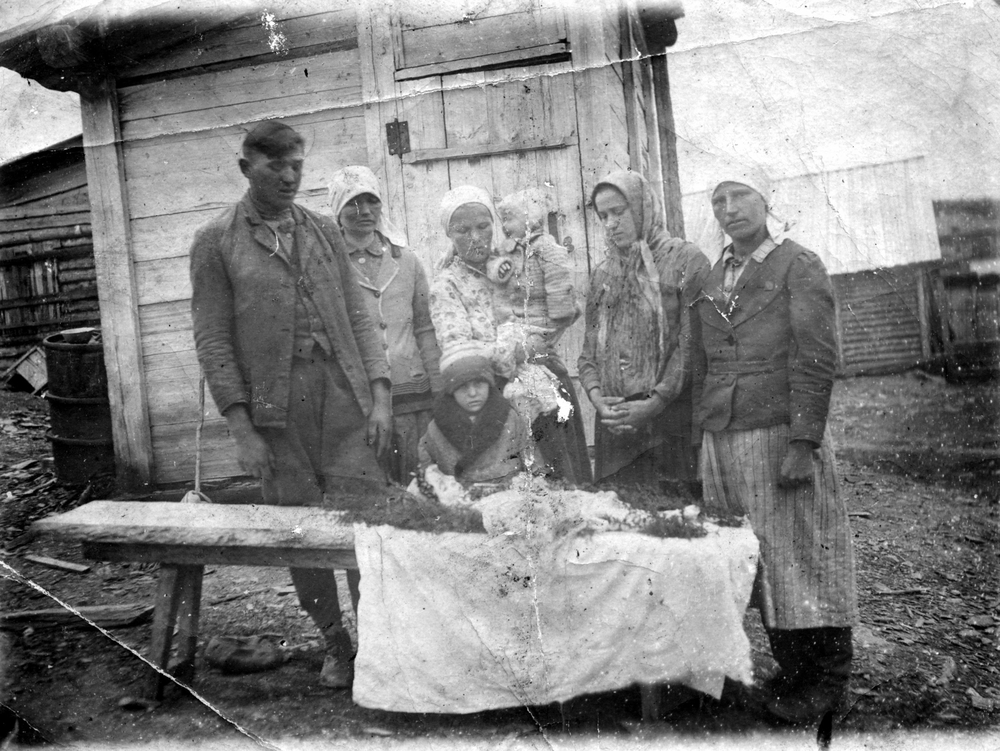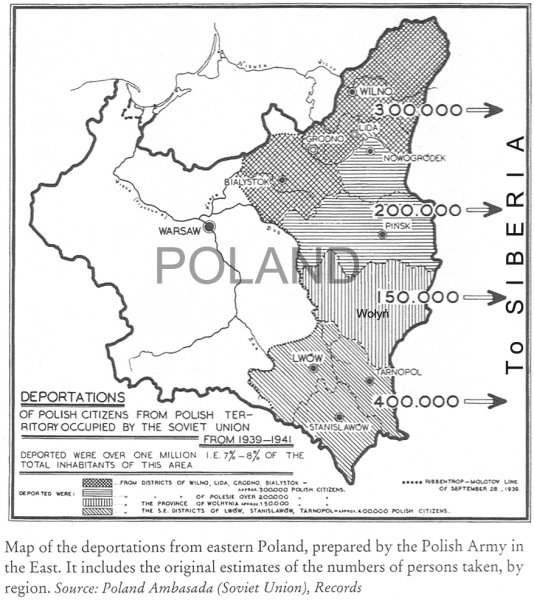
#OTD 81 years ago, the USSR began the first WWII mass deportation of Polish citizens from the eastern borderlands occupied by the Soviet Union on Sept. 17, 1939.
Polish fellers (incl. children) at the #Połdniewica posiołek, Gorky Oblast, USSR. 1940/41. (Collection of W. Maj)
Polish fellers (incl. children) at the #Połdniewica posiołek, Gorky Oblast, USSR. 1940/41. (Collection of W. Maj)

During #WWII, Polish civilians were deported by the USSR in four waves: February 10, April 13, and June 29, 1940, and June 1941.
The deportations were executed as part of a campaign to rid the region of “anti-Soviet elements” deemed hostile to communist rule.
The deportations were executed as part of a campaign to rid the region of “anti-Soviet elements” deemed hostile to communist rule.
This map – created by the Cartography Service of the Polish Army in the East – estimates the total number of Polish citizens (1,050,000) deported by the USSR from Soviet occupied eastern Poland during the years 1939-1941. Results are shown by region. 

Each deportation had a distinctive character and targeted specific categories of individuals in occupied eastern Poland. The Soviet classifications of exiles in the deportations determined the length and location of exile as well as the type of labor assigned.
In Dec. 1939, NKVD chief L. Beria recommended the deportation of Polish military settlers, veterans who fought in the Polish-Soviet War and received land in the borderlands.
The deportation category of “osadnicy” later expanded to include civilian settlers & small farmers.
The deportation category of “osadnicy” later expanded to include civilian settlers & small farmers.
The deportation of military settlers was authorized on Dec. 29, 1939. The NKVD was instructed to arrange rail transports to the USSR, and regulations were issued regarding labor and the Soviet camps selected to receive the Polish deportees. 

Polish deportees were sentenced to forced labor in timber logging special settlements located in the Kirov, Perm, Vologda, Arkhangelsk, Ivanovo, Omsk, Sverdlovsk, Yaroslavl, and Novosibirsk oblasts, the Komi ASSR, and the Krasnoyarsk and Altai Krai regions. #WWII
With military training, extensive networks, and knowledge of the land, foresters were included in this deportation.
Others identified for exile included judges, civil servants, professors, attorneys, police officers, clergy, artisans, and the family members of all targeted.
Others identified for exile included judges, civil servants, professors, attorneys, police officers, clergy, artisans, and the family members of all targeted.
Lists of foresters and military settlers identified for deportation were set by early January, and a Sovnarkom decree issued on Jan. 14, 1940, specified the mining of gold and copper as an additional (and exceptionally deadly) category of forced labor for the Polish deportees.
The majority of Polish citizens deported on Feb. 10, 1940, were sent to special settlements in Northwest Russia, including Arkhangelsk Oblast.
This map of work camps for the Polish population (1940-41) in Arkhangelsk Oblast was produced by A. Gurjanow of Memorial.
This map of work camps for the Polish population (1940-41) in Arkhangelsk Oblast was produced by A. Gurjanow of Memorial.

Mietek G. wrote about his encounter with the NKVD on the night of his deportation, and he also described the conditions of his transport in a cattle car from the Lwów region to Arkhangelsk Oblast in the USSR. 

“The screams of mothers were so frightful that one could go mad.”
On a night when temperatures reached -40° C in parts of the borderlands, some children froze to death prior to arriving at train stations. Deportees often waited in cattle cars for days prior to departure.
On a night when temperatures reached -40° C in parts of the borderlands, some children froze to death prior to arriving at train stations. Deportees often waited in cattle cars for days prior to departure.
With 40-80 people crammed and locked into frigid cattle cars, deportees froze or died from starvation and illness during the 2-4 week journey to the USSR. Those who did arrive in the USSR were in weakened states & faced additional travel on foot/sleigh to reach isolated camps.
“There were 18 wooden barracks, which housed 2,500 prisoners. The barracks were built from rough logs. The cracks between were filled with dry moss full of bed bug eggs which later turned into bedbugs & infested our wooden beds….”
M. Romanko. #Połdniewica camp, 1940/41.
M. Romanko. #Połdniewica camp, 1940/41.

The health of the deportees in the camps disintegrated steadily due to hunger, epidemics, unreasonable labor quotas, and the absence of medical care. Children were often the first to perish.
A. Cywińska (b. 1938) died soon after Feb. 10 deportation to Krasnoyarsk Krai. 1940.
A. Cywińska (b. 1938) died soon after Feb. 10 deportation to Krasnoyarsk Krai. 1940.

At Połdniewica, dysentery and a typhus epidemic swept through the camp, spiking the mortality rate and particularly affecting young adults.
750 Polish exiles were buried near the #Połdniewica posiołek in Gorky Oblast, USSR. 1940/41.
(Collection of M. Romanko)
750 Polish exiles were buried near the #Połdniewica posiołek in Gorky Oblast, USSR. 1940/41.
(Collection of M. Romanko)

“Violently torn away from our past and not yet having become grafted on to any future, our extraordinary mutilated lives existed in a void.”
Zoe Zajdlerowa wrote 𝗧𝗵𝗲 𝗗𝗮𝗿𝗸 𝗦𝗶𝗱𝗲 𝗼𝗳 𝘁𝗵𝗲 𝗠𝗼𝗼𝗻 (1947) using documents provided by Gen. Władysław Sikoski.
Zoe Zajdlerowa wrote 𝗧𝗵𝗲 𝗗𝗮𝗿𝗸 𝗦𝗶𝗱𝗲 𝗼𝗳 𝘁𝗵𝗲 𝗠𝗼𝗼𝗻 (1947) using documents provided by Gen. Władysław Sikoski.

• • •
Missing some Tweet in this thread? You can try to
force a refresh






